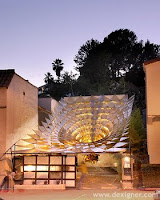
It wasn't so long ago that the Moebius strip was the favored metaphor of cool architects and critics. Then black holes became the thing, in part because of
Maximilian's Schell (left), Ball-Nogues Studio's influential 2005 installation at
Materials & Applications, Silverlake. The work's title refers to an actor in the 1979 sci-fi film
The Black Hole who rants about marshaling "the power of the vortex" and uncovering "the great truth of the unknown!" [The Disney movie, in turn, unintentionally evokes Bruce Nauman's 1967
The True Artist Helps the World by Revealing Mystic Truths.]

Benjamin Ball and Gaston Nogues developed the space-warp motif further in such hip venues as P.S. 1 (2007) and the Coachella Music Festival (2008). But with their new installation at MOCA Pacific Design Center,
Feathered Edge, black holes are out and the catenary is in. As every architecture student knows, a catenary is the curve a heavy, flexible string or chain assumes when suspended from two points. It is the basis of every suspension bridge. Like architecture itself, the catenary is about gravity constrained (the black hole, about gravity unbounded. Black hole = id, catenary = superego.) Eero Saarinen turned the catenary upside-down for the St. Louis
Gateway Arch (1947), and the curve became one of Jasper Johns' more inscrutible obsessions. Not every arch is a catenary: the McDonalds golden arches are parabolas, as are the sides of the Eiffel Tower.
 Feathered Edge
Feathered Edge offers this summer's extreme catenary experience — some 21 miles' worth of suspended, digitally mapped, colored twine. All well and fine, the curmudgeon may say. What do these catenaries and black holes have to do with actual buildings? It's a good question. You won't find entirely satisfying
answers from Ball or MOCA curator Brooke Hodge in Sunday's L.A. Times. Perhaps architecture's math-mania reflects the fact that just about zero is being built lately — and is a comment on an economy founded on imaginary numbers.

 It wasn't so long ago that the Moebius strip was the favored metaphor of cool architects and critics. Then black holes became the thing, in part because of Maximilian's Schell (left), Ball-Nogues Studio's influential 2005 installation at Materials & Applications, Silverlake. The work's title refers to an actor in the 1979 sci-fi film The Black Hole who rants about marshaling "the power of the vortex" and uncovering "the great truth of the unknown!" [The Disney movie, in turn, unintentionally evokes Bruce Nauman's 1967 The True Artist Helps the World by Revealing Mystic Truths.]
It wasn't so long ago that the Moebius strip was the favored metaphor of cool architects and critics. Then black holes became the thing, in part because of Maximilian's Schell (left), Ball-Nogues Studio's influential 2005 installation at Materials & Applications, Silverlake. The work's title refers to an actor in the 1979 sci-fi film The Black Hole who rants about marshaling "the power of the vortex" and uncovering "the great truth of the unknown!" [The Disney movie, in turn, unintentionally evokes Bruce Nauman's 1967 The True Artist Helps the World by Revealing Mystic Truths.] Benjamin Ball and Gaston Nogues developed the space-warp motif further in such hip venues as P.S. 1 (2007) and the Coachella Music Festival (2008). But with their new installation at MOCA Pacific Design Center, Feathered Edge, black holes are out and the catenary is in. As every architecture student knows, a catenary is the curve a heavy, flexible string or chain assumes when suspended from two points. It is the basis of every suspension bridge. Like architecture itself, the catenary is about gravity constrained (the black hole, about gravity unbounded. Black hole = id, catenary = superego.) Eero Saarinen turned the catenary upside-down for the St. Louis Gateway Arch (1947), and the curve became one of Jasper Johns' more inscrutible obsessions. Not every arch is a catenary: the McDonalds golden arches are parabolas, as are the sides of the Eiffel Tower.
Benjamin Ball and Gaston Nogues developed the space-warp motif further in such hip venues as P.S. 1 (2007) and the Coachella Music Festival (2008). But with their new installation at MOCA Pacific Design Center, Feathered Edge, black holes are out and the catenary is in. As every architecture student knows, a catenary is the curve a heavy, flexible string or chain assumes when suspended from two points. It is the basis of every suspension bridge. Like architecture itself, the catenary is about gravity constrained (the black hole, about gravity unbounded. Black hole = id, catenary = superego.) Eero Saarinen turned the catenary upside-down for the St. Louis Gateway Arch (1947), and the curve became one of Jasper Johns' more inscrutible obsessions. Not every arch is a catenary: the McDonalds golden arches are parabolas, as are the sides of the Eiffel Tower.  Feathered Edge offers this summer's extreme catenary experience — some 21 miles' worth of suspended, digitally mapped, colored twine. All well and fine, the curmudgeon may say. What do these catenaries and black holes have to do with actual buildings? It's a good question. You won't find entirely satisfying answers from Ball or MOCA curator Brooke Hodge in Sunday's L.A. Times. Perhaps architecture's math-mania reflects the fact that just about zero is being built lately — and is a comment on an economy founded on imaginary numbers.
Feathered Edge offers this summer's extreme catenary experience — some 21 miles' worth of suspended, digitally mapped, colored twine. All well and fine, the curmudgeon may say. What do these catenaries and black holes have to do with actual buildings? It's a good question. You won't find entirely satisfying answers from Ball or MOCA curator Brooke Hodge in Sunday's L.A. Times. Perhaps architecture's math-mania reflects the fact that just about zero is being built lately — and is a comment on an economy founded on imaginary numbers.
Comments